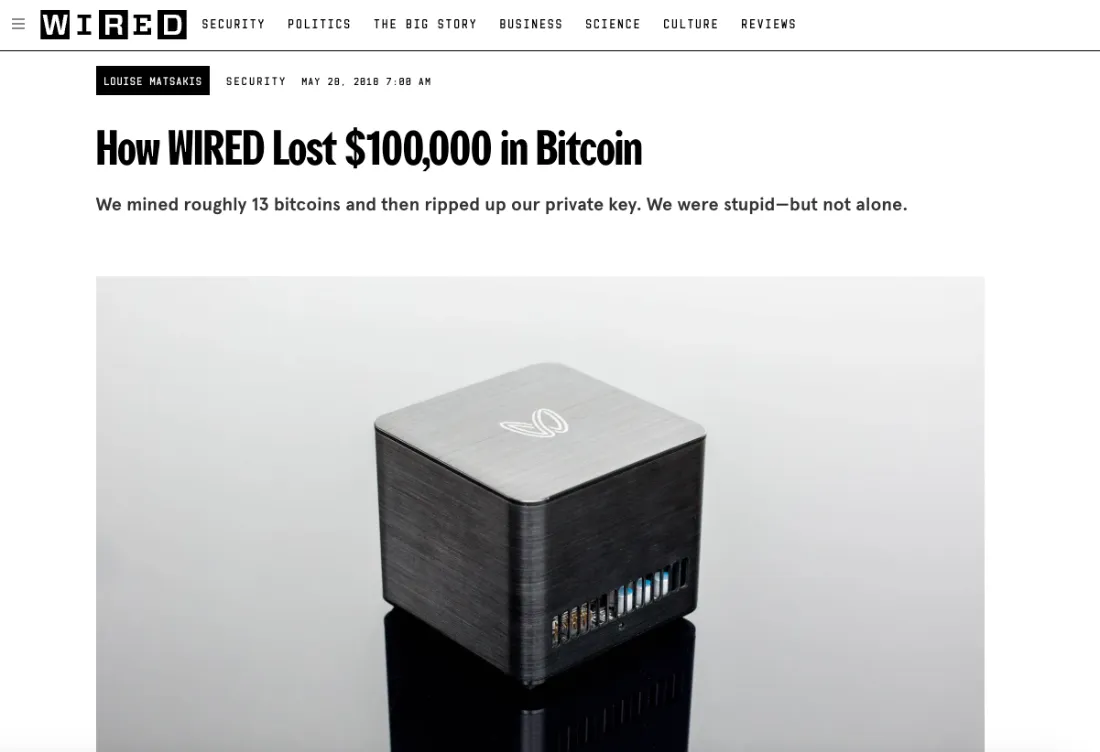UNWIRED
May 11, 2013
1BTC:$115.640000
- Artist
- Fact Date
- Fact #
- undefined
- Printing Specifications
- Paper / Stock
- Page Size
There’s dumb and then there’s deliberately destroying the private key to a 13 BTC wallet dumb. As tech media, Wired should have known better than to fade Bitcoin, but its staffers seemed intent on proving some point about value being an “abstraction.” The publication has never lived it down.
You’d have thought that mainstream tech and financial media would have “gotten” Bitcoin. You’d have thought wrong. Several of the world’s leading publications, including the Financial Times, mocked it for years, even after it had become apparent that Bitcoin was going to be huge. And no media organisation ended up with more egg on its face than Wired.

What began as a seemingly straightforward test of a new piece of hardware evolved into a piece of performance art, culminating in a decision that would cement Wired’s place in the annals of cryptocurrency lore. On April 26, 2013, Wired senior writer Robert McMillan published an article titled “Wired Fires Up New Bitcoin Miner, World Drools.” The timing was impeccable. The article was published just weeks after Bitcoin’s first major price bubble that saw it climb from $13 at the start of the year to $265 in early April before crashing violently.
The centrepiece of the experiment was a piece of hardware that represented a pivotal technological shift in Bitcoin mining: one of the first ASIC rigs, capable of finding coins much more efficiently than the GPUs in use at the time. The manufacturer of the device in question was also significant, for its name was destined to become notorious on account of the thousands of preorders it took but ultimately never fulfilled: Butterfly Labs.
Wired’s Robert McMillan found himself in the privileged position of being one of the few people in the world to get their hands on a Butterfly Labs machine. It was wasted on him.
Mining for Fun
To conduct the experiment, Wired created a Bitcoin wallet, connected its Butterfly Labs machine to a mining pool, and fired up the device. Over the course of several weeks, the wallet accumulated a total of 13.34 BTC, worth around $1,300. Not bad for a piece of hardware that only cost $240.
By mid-May, with the digital coffers swelling, a question arose within the Wired newsroom: what should be done with the money? The staff debated several options. One suggestion was to donate the funds to a charity, an act that would have provided a tangible social benefit from their experiment. However, a more radical idea began to take hold.
On May 13, Wired updated its readers with its decision: they were going to destroy the private key to the wallet. The official rationale was one of journalistic ethics. As an institution reporting on the burgeoning and controversial world of cryptocurrency, holding a financial stake in Bitcoin, however small, could create a conflict of interest that might compromise its objectivity. It’s hard not to detect a faint sneer in their message, however: this was frivolous internet money and it would be no loss if it were written off for good.

By deleting the private key, Wired was severing the cryptographic link that granted ownership and control over the funds in the public address. The 13.34 BTC would not be moved or spent; they would be rendered permanently inaccessible. It was a performative act of destruction, framed as a profound statement on the very nature of this new form of money. From a journalistic perspective, this was the stuff that clicks were made of. But as a financial decision it was, well, bold to put it mildly. Even as they destroyed the private key, Wired’s staffers must have been silently praying that the decision would not come back to haunt them.
The destruction of the private key in May 2013 marked the end of Wired's experiment with Bitcoin, but it was only the beginning of the story, which has since attained legendary status. What was initially a niche article about a tech curiosity has metastasised into a cautionary tale about the perils of writing off Bitcoin, be it for ethical reasons or otherwise.
Wired's experiment concluded that Bitcoin was an abstraction, but its true legacy is as a concrete and permanent reminder of the immense cost of underestimating a technology whose story was just beginning.
- Artist
- XXXXX
- BTC On this day
- May 11, 2013
- Market Cap
- $1,288,469,553
- Block Number
- 235,682
- Hash Rate
- 88.57 TH/s
- Price Change (1M)
7%
- Price Change (3M)
382%
- Price Change (1Y)
2231%
